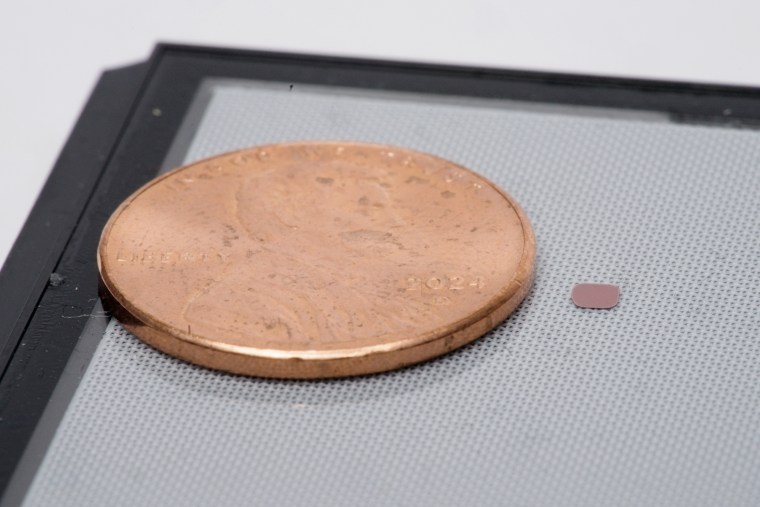Individuals with a number one reason behind blindness had been capable of learn once more because of a tiny wi-fi chip implanted behind the attention and specialised augmented glasses, based on examine outcomes printed Monday within the New England Journal of Medication.
The trial concerned 38 European sufferers, all of whom had a sophisticated stage of dry age-related macular degeneration (AMD) often called geographic atrophy.
There isn’t a remedy for AMD, which is pushed by modifications in part of the retina referred to as the macula and brought on by irritation and a build-up of waste. The photoreceptor cells within the macula are answerable for producing sharp, detailed and coloured imaginative and prescient. When the illness has progressed to the geographic atrophy stage, these cells deteriorate and die, and other people lose their central imaginative and prescient — which means that an object straight forward could seem blurry or coated up with a darkish blotch.
Roughly 22 million folks within the U.S. have AMD, and about 1 million have geographic atrophy, based on the American Macular Degeneration Basis.
Within the examine, the individuals, who had a median age of 79, had been fitted with the “PRIMA gadget,” a system meant to duplicate imaginative and prescient. Sufferers put on augmented actuality glasses embedded with a digicam that captures their visible discipline. What the digicam “sees” is transmitted to the chip implanted of their eye within the type of infrared gentle. The chip converts the sunshine into {an electrical} present, which stimulates the remaining wholesome cells within the macula in a sensible manner, enabling indicators these cells ship to be interpreted by the mind as imaginative and prescient.
A picture processor, which the consumer should carry, lets sufferers zoom in and enlarge the photographs they see, which seem in black and white.
With the assistance of the PRIMA gadget, 80% of the 32 sufferers who returned for a reassessment one yr after the chip implantation had achieved clinically significant visible enhancements. Sufferers did expertise unwanted side effects, predominantly associated to the surgical process: The examine reported that 26 severe antagonistic occasions occurred in 19 of the sufferers, starting from elevated blood strain within the eye to an accumulation of blood across the retina. Nearly all of the antagonistic occasions resolved inside two months of the implantation.
“It’s the primary ever therapeutic strategy that has led to an enchancment in visible operate on this group of sufferers,” stated Dr. Frank Holz, the trial’s lead investigator and chair of the division of ophthalmology on the College Hospital of Bonn in Germany. “Late-stage age-related macular degeneration is a dismal illness. Sufferers are now not able to studying, driving a automobile, watching TV and even recognizing faces. So [these results] are a game-changer in my thoughts.”
One affected person, Sheila Irvine, 70, who was fitted with the PRIMA gadget at Moorfields Eye Hospital in London, stated in an announcement offered by the hospital that her life earlier than receiving the implant was akin to “having two black discs in my eyes, with the skin distorted.” A self-described “avid bookworm” earlier than shedding her imaginative and prescient, Irvine stated she was now capable of do crosswords and browse prescriptions.
Dr. Sunir Garg, professor of ophthalmology on the retina service of Wills Eye Hospital in Philadelphia, who was not concerned within the examine, stated the outcomes characterize a breakthrough for sufferers with geographic atrophy. All medical doctors have been capable of supply, he stated, are visible aids, like magnifiers, and emotional help.
“Even with new medical therapies, the very best that we will do is sluggish it down,” stated Garg, who works with a number of drugmakers concerned in remedies for AMD, together with Apellis Prescription drugs, the maker of pegcetacoplan. That drug, which slows the development of geographic atrophy, was lately authorised within the U.S. and have to be injected into the attention each 1 to 2 months. “We will’t cease it, and we will’t do something to convey again misplaced imaginative and prescient.”

Dr. Demetrios Vavvas, director of the retina service at Mass Eye and Ear in Boston, who was additionally not concerned within the examine, stated that the PRIMA system is just not with out limitations.
Vavvas famous that the surgical procedure required to implant the chip within the eye requires a excessive stage of surgical ability and isn’t with out danger. “It’s a must to carry the retina off its regular place to implant this gadget, which will increase the atrophy,” stated Vavvas, who’s a advisor to Sumitomo Prescription drugs, an organization engaged on stem cell therapies for sufferers with different types of imaginative and prescient loss.
Vavvas stated it was vital to notice that the gadget isn’t restoring regular imaginative and prescient, as sufferers had been solely capable of see in black and white slightly than coloration, and the trial individuals needed to endure a major quantity of coaching in an effort to learn to see with the PRIMA gadget. He additionally stated that it wasn’t clear whether or not the enhancements in visible capability had considerably improved the sufferers’ high quality of life.
However on the identical time, Vavvas was additionally optimistic about its future potential, describing the present iteration of PRIMA as a key stepping stone within the visual field restoration.
“Consider this gadget because the pre-release iPhone,” he stated. “The constraints are clear. We shouldn’t oversell that the standard of life actually improved. However there have been sure [visual] duties at which the sufferers had been clearly higher. So it exhibits to us that there’s potential on this strategy. It’s nonetheless in some methods, a prototype. They’re engaged on iterations of this gadget that can be higher.”
New upgrades to the PRIMA gadget may very well be coming within the subsequent couple of years.
The PRIMA system was invented by Stanford College ophthalmology professor Daniel Palanker and is being developed by the California-based neural engineering firm Science Company.
Palanker stated technical enhancements are being made to extend the variety of pixels within the chip from 400 to 10,000. The brand new chips have already been examined in rats, and the upgraded chips are being manufactured for future human trials. With assistance from the digicam’s zoom operate, Palanker stated that this might theoretically allow sufferers to realize 20/20 visible decision.

“We’re additionally engaged on subsequent era software program that may enable sufferers to understand not simply black-and-white textual content, but in addition grey-scale pure pictures, reminiscent of faces,” Palanker stated.
Palanker prompt that the expertise may very well be trialed in different retinal ailments that trigger blindness, reminiscent of Stargardt illness, which has comparable signs to age-related macular degeneration however is genetic and often impacts youthful folks.
Garg and Vavvas are desperate to see bigger trials that present extra particulars about how the gadget improves sufferers’ capability to operate on a day-to-day foundation. Vavvas prompt that future trials ought to embody a management arm to grasp the extent to which the gadget yields real-world advantages, for instance in comparison with current digital magnifiers.
“Is it one thing that’s ok for sufferers to say, ‘Properly, I’ve regained my independence as a result of I can now do my bank card payments myself, stamp and tackle my envelopes myself, and take a look at grocery retailer labels?’” Garg stated. “These sorts of sensible issues I want to know extra about.”
“It is a power illness that you’ll have for all times, so we want multiple yr of follow-up to see different dangers, different issues,” Vavvas stated. “Does that sign of efficacy that we see at 12 months, stay two years later?”
Whereas Vavvas stated he wouldn’t name the gadget an entire panacea for blindness, the examine confirmed that brain-computer interfaces can characterize an vital strategy to tackling completely different sorts of extreme visible impairment. “Because the iterations of this gadget grow to be higher and higher, it may grow to be an actual answer for a cohort of sufferers,” he stated.











